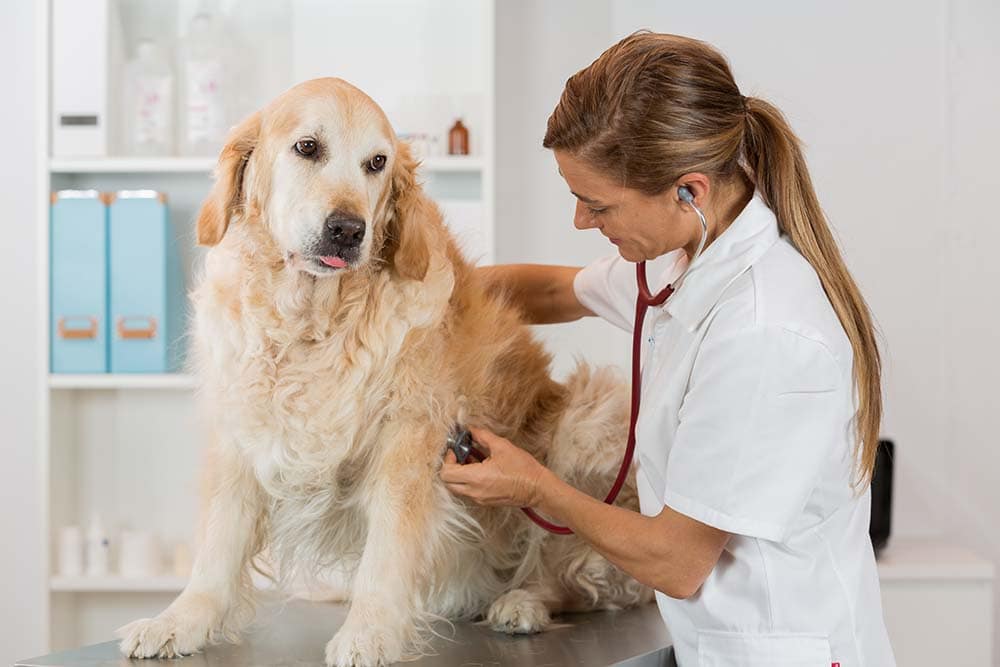8 Golden Retriever Health Issues to Watch Out For
Updated on

Golden Retrievers are sweet, docile, and loving dogs that make exceptional family companions. They are one of the most popular dog breeds in the United States, and with good reason. They have an easy temperament and love their human families. They also do well with other pets in the household, and they are easy to train. These dogs are highly intelligent, and they do well with children.
Obviously, Golden Retrievers make excellent family pets, but what about health issues to watch out for? Are they prone to certain medical conditions? Yes, they do have health issues to watch for, but all dogs are predisposed to something.
In this article, we’ll list and explain eight medical conditions that Golden Retrievers may inherit through their bloodlines so that you have the information needed to ensure your Golden lives a long and healthy life.
Top 8 Common Golden Retriever Health Issues:
1. Atopic Dermatitis
Atopic dermatitis is a chronic skin disease brought on by different allergens like dust mites, pollen and mold spores. This condition is considered a polygenetic condition, and Goldens are prone to this skin problem. It’s hard to spot skin allergies in Goldens because of their thick coats, but some symptoms to watch for are biting at the skin, licking the paws, hair loss, scratching, rubbing against the floor, open wounds, and foul odors.
Symptoms usually appear from 3 months to 6 years of age. If you notice any of the symptoms mentioned above, it’s best to make a trip to the vet for an examination. The best way to treat this condition is to eliminate the triggers, and that’s where your veterinarian can help with determining the cause and prescribe any medications necessary to treat it. It is a lifelong condition and treatment is aimed at control and reducing flare ups.

2. Cataracts
Cataracts are a cloudy, white film in the lens of the eye that impairs vision and, in some cases, can cause total blindness in the affected eye. Cataracts usually occur as the dog ages, and there is no prevention for the condition. Dogs with diabetes are more prone to developing cataracts.
There is no way to prevent cataracts but taking your Golden for regular check-ups will help you stay on top of any medical conditions.
3. Panosteitis
Panosteitis is a painful condition of one or more long bones in the legs due to increased pressure in the bone or stimulation of the pain receptors in the outer soft tissue lining of the bone. It is sometimes referred to as “growing pains.” The condition can come on suddenly without excessive exercise or any trauma.
The tell-tale symptom is lameness in the affected leg, and it occurs in younger dogs, typically around 5–14 months old. The condition miraculously disappears once the dog reaches 2 years of age.
You’ll want to take your dog to the vet if you notice any lameness in the legs. If your vet suspects panosteitis, X-rays will be taken to make a correct diagnosis. Pain and anti-inflammatory medications help with the pain until it resolves on its own.

4. Bloat
Bloat is when the stomach fills with air/food/fluid and can result in GDV if the stomach twists on its axis, and it’s a medical emergency if this happens. GDV-Gastric dilatation and volvulus- seems to occur in large-chested dogs and the exact mechanism is still being investigated. The condition can occur if the dog overeats or exerts itself immediately after eating. Symptoms are an enlarged abdomen, excessive drooling, unproductive vomiting, labored breathing, a weak pulse, or pale nose and mouth. Bloat is often caused by overeating such as a dog getting into a whole bag of food.
As we’ve stated, bloat and GDV is a medical emergency, and you’ll need to take your dog to the vet immediately if you see any of the symptoms mentioned above.
5. Hypothyroidism
Hypothyroidism is when the thyroid gland does not produce enough thyroxine, which is the hormone responsible for turning food into fuel. This disease is relatively common in dogs, but Golden Retrievers are among the breeds it affects the most. Some common symptoms are hair loss, flakey skin, weight gain, ear and toenail infections, lethargy, and a slowed heart rate.
Thankfully, the condition is not usually life-threatening, and it’s easy to treat. If your dog is diagnosed with hypothyroidism, it’ll be on medication for the rest of its life. Your dog will need treatment to increase its quality of life and maintain their metabolic processes.

6. Hip Dysplasia
Hip dysplasia can occur in any sized breed, but it’s more common in larger dogs. This painful condition is when the head of the thigh bone does not fit into the groove of the hip socket properly. The result is bone grinding upon bone, and it leads to deterioration of the bone over time, which leads to loss of functionality. This is in part a genetic condition, but it can be brought on by malnutrition, obesity, excessive exercise, and an excessive growth rate.
Symptoms can arise as early as 4 months old, but they can strike at any time. Symptoms include lameness in the affected leg, hesitation to jump or run, limping, stiffness, decreased range of motion, and decreased activity.
Anytime you see your dog limping, or your dog has developed no desire to play and run, you should have your dog evaluated by your vet. Physical therapy and anti-inflammatory medications are often used to treat hip dysplasia, and if your dog is obese, weight loss is vital. Joint supplements and special foods can provide some relief, as well.
7. Aortic Stenosis
Aortic stenosis is a narrowing of the aortic valve in the heart, which in turn causes insufficient blood flow and circulation from the heart. Often, a dog with aortic stenosis will show no signs initially; if that’s the case, your veterinarian may detect a heart murmur upon an examination. Heart disease can occur as early as 6–12 months of age, and in severe cases, it leads to heart failure.
Your veterinarian will take chest X-rays or perform an echocardiogram to determine the severity, along with routine blood work. In mild cases, no treatment is necessary, but your vet will keep a close eye on the progression. In moderate to severe cases, your vet may put your dog on beta-blockers, which slow the heart rate and makes the heart work more efficiently.
It’s important to limit exercise if your dog is diagnosed with aortic stenosis. Your vet can inform you about if and when you can exercise your Golden Retriever.

8. Cancer
Golden Retrievers can live anywhere from 10–12 years of age, but they are susceptible to these types of cancer:
Mast cell tumor: A tumor with mast cells that pop up on the skin, usually in raised, red bumps. If caught early, the tumor can be removed safely, and 60%–70% of dogs will have only one in their lives. However, if left untreated, it can cause other problems and spread into other areas of the body, such as the liver, spleen, or lymph nodes.
Lymphoma: A type of cancer originating in the lymphocyte cells that are part of the immune system. A typical initial symptom is enlarged lymph nodes, which are located under the jaw, behind the knees, or in front of the shoulders.
Hemangiosarcoma: This type of cancer occurs in the spleen but can spread to other organs, and it affects middle-aged to senior dogs. Prognosis is poor, unfortunately, because the tumors will rupture eventually, causing severe blood loss. Often, you may not be aware your dog has this cancer until the tumor ruptures. Chemotherapy and surgery are usually used for treatment.
A cancer diagnosis can be scary, but it’s extremely important to take your dog to the vet to get a proper diagnosis so that a treatment plan can be implemented. You know your dog the best, and if you suspect something is just not right, take your dog to the vet immediately.
Conclusion
Golden Retrievers make wonderful pets, and just because these sweet and loving dogs are predisposed to these conditions, it doesn’t mean they will definitely have them. If you’re looking for a Golden from a breeder, ensure the breeder is reputable. A responsible and reputable breeder will ensure the parents are healthy before breeding, and they will disclose to you any sickness the dogs may have had.
A responsible breeder will be happy to answer all your questions, and they will be highly knowledgeable about the breed. All puppies will have all vaccinations, and you’ll receive a health guarantee. If a breeder does not disclose this information, that’s a red flag. You should also be allowed to visit the home of the breeder to ensure the dogs and puppies are well taken care of.
We hope this information helps you understand the potential health risks in Golden Retrievers, but don’t let these conditions deter you from owning one. With proper care and diet, most of these conditions can be kept at bay or maybe even never emerge.
Featured Image Credit: Olena Brodetska, Shutterstock













